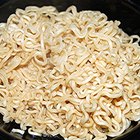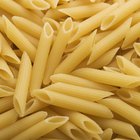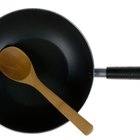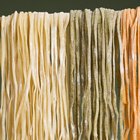
Boiling fresh egg pasta for lasagna is not a must, but is definitely recommended if you like your noodles al dente. While it is possible to just layer your ingredients immediately with your freshly made pasta, the lasagna will turn out on the mushy side. The hour-long process of baking the lasagna in the oven allows your sauce to soften your noodles. Boiling, freezing, or drying your lasagna noodles beforehand helps them hold up to the sauce and keep your lasagna on the firm side.
Boiling Lasagna Noodles
Boil water in a very large pot, salt generously and add your fresh pasta, a couple sheets at a time. If you add too many sheets of pasta at once, the pot ends up too crowded and the sheets may stick together. Cook for one to two minutes per sheet, remove with tongs and place on a large greased plate or baking sheet. Now, your pasta is ready to layer with the rest of your lasagna ingredients.
Freezing Lasagna Noodles
Instead of boiling your noodles, you can freeze them to ensure they don’t turn to mush in the oven. This method can come in handy if you’ve decided to make your pasta a few days ahead of time. Place the fresh egg pasta in a single layer on a baking sheet or plate, cover and place in the freezer until frozen. Remove the frozen lasagna noodles and consolidate them into a large freezer bag or storage container. Simply remove when ready to bake and layer the frozen noodles with the other ingredients.
Drying Lasagna Noodles
You can dry your fresh egg pasta as a way to prevent your pasta from becoming mushy. Like freezing, drying can preserve your noodles and allow you to make them ahead of time. After making your pasta, drape the individual noodles over a pasta drying rack, the handle of a wooden spoon or even a clothes hanger for one to three hours until firm and dry. Do not over-dry the pasta, or it will become brittle and crumble. Store the dried noodles in an airtight container until just before making the lasagna.
More From-Scratch Ingredients
If you’ve decided to purchase or make fresh egg noodles for your lasagna, you have just taken this classic Italian dish to the next level. If you feel like going one more mile, make other components of lasagna from scratch, too. Instead of using jarred tomato sauce, make your own marinara using sautéed onions, garlic, canned or fresh tomatoes and herbs. Make your own béchamel sauce by making a roux of butter and flour, mixing in cream or milk and simmering until thickened for an extra creamy lasagna.
Related Articles

How Long Is Fresh Pasta Supposed to Dry ...

Do You Need to Cook Fresh Made Lasagna ...

How to Make Fried Ramen Noodles

How to Use a Ravioli Maker

How to Make Pasta Pink by Using Beet ...

Directions on How to Cook Soba Noodles

Can I Pour Hot Water in a Baking Dish ...

Calories in Pasta Noodles

How to Fry Raw Spaghetti

Homemade Polish Kluski Noodles

How to Cook & Freeze Spaghetti Noodles
How to Cook Large Amounts of Noodles ...
Can Lasagna Be Preassembled With Egg As ...

Can Fresh Pasta Be Dried Even if It Has ...

Can You Use Vegetable Oil Instead of ...

How to Clean Soft-Shell Clams (Steamers)

How to Cook Luglug Cornstarch Noodles

Baked Pasta With Cottage Cheese

Cooking Dried Banh Pho Noodles

How to Make a Layered Lasagna With ...
References
Resources
Writer Bio
Maya Silver is an editor at DiningOut Magazines. She is the author of "My Parent Has Cancer And It Really Sucks" and has written for "U.S. News & World Report," the "Washington Post Express" and local newspapers and magazines. She has helped hundreds of homes make energy improvements. Her culinary knowledge stems from professional and personal cooking experience.
Photo Credits
Eising/Photodisc/Getty Images